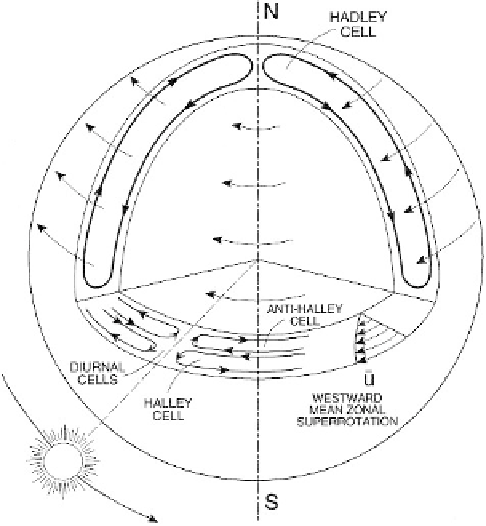Geology Reference
In-Depth Information
on Venus, 62% are relatively pristine and only 4% are
partly embayed by lava
flows, with the remainder being
partly degraded by tectonic processes. If resurfacing took
place by prolonged volcanism, one would expect a greater
number of craters displaying various stages of burial; thus,
their absence supports the catastrophic overturning model.
On the other hand, if substantial blocks of terrain were
found in which remnants of large craters were preserved, it
would show that the earlier rock record is preserved in
some places and argue against complete global overturn-
ing of the lithosphere. Although such terrains have not
been found, it is possible that the low resolution of the
Magellan data does not allow one to discern remnants of
highly deformed craters.
Most geophysical models of the interior suggest that
the current heat
flow from the surface is less than the heat
being generated, even taking into account the large num-
ber of hot spots. The result is that with time heat is
accumulating below the lithosphere, which could lead to
a catastrophic overturning, and it is thought that such
cycling could occur every 0.5 Ga.
The history subsequent to the resurfacing at 0.75
Ga (regardless of mechanism) is also debated, with two
general hypotheses in contention: (a) an episodic history
punctuated with speci
c geologic processes, and (b) a
non-episodic history characterized by uniform geologic
processes spread throughout time. In the
first case, it is
assumed that all geologic features of a speci
c type
formed at the same time, such as the coronae, regardless
of geographic location. This inference is based partly on
stratigraphic relations with other terrains, such as plains,
and tectonic features. In the second case, detailed mapping
suggests that the formation and evolution of many fea-
tures, such as the large volcanoes, spans a long period of
time, with volcanic materials
“
inter-
ngering
”
with tec-
tonic deformation in a patch-work pattern of local resur-
facing. In both models, there is agreement that complex-
ridged terrain and the formation of tesserae represent some
of the earliest visible rock record, but that, in the non-
episodic model, some younger tesserae can be identi
ed.
What processes might be taking place today on Venus?
There are no observations of changes on the surface with
available data; i.e., no new lava
flows, new landslides, or
changes in wind-related features. But it must be remem-
bered that the available data are extremely limited for
detecting such changes, and variations in the abundance
of sulfur dioxide in the atmosphere led Larry Esposito
(
1984
) to suggest that volcanoes might at present be
erupting, an idea supported by some Venus Express data.
Figure 6.31. A diagram showing the global circulation of Venus
'
atmosphere as modeled and con
rmed by near-surface wind
patterns derived from the orientations of wind streaks. This pattern
re
ects Hadley cell circulation that takes into account factors such as
solar heating and planetary rotation.
materials to expose an underlying rougher surface. Wind
streaks
“
point
”
in downwind directions and are used to
map global near-surface winds. The results show that
global winds blow toward the west
(Fig. 6.31)
.
6.6 Geologic history
Comparison of the geologic histories for the terrestrial
planets poses an intriguing problem. As shown in
Fig. 4.50
, the rock records for Mercury, the Moon, and
Mars can be traced back to the
final stages of terminal
accretion, marked by an abundance of large impact cra-
ters. Except for Earth, the geologic time scales of the
terrestrial planets are based mostly on the numbers of
superposed impact craters on mappable units and the
stratigraphic horizons provided by widespread ejecta
from major impacts, such as the Fra Mauro Formation.
on the Moon. The paucity of large craters on Venus
precludes this approach and suggests a surface age of
0.75 Ga or younger. This leads to a controversy regarding
the styles of resurfacing, with two competing ideas:
(a) rapid, catastrophic overturning of the lithosphere; and
(b) slower, local resurfacing by volcanism. Of the craters




